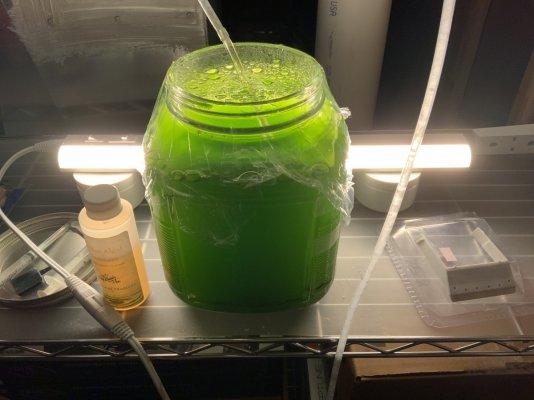I recently delved into the world of phytoplankton culturing. My first attempt with Nannochloropsis in 500ml plastic bottles started off well but stalled after 3 weeks: it hasn't crashed yet but it's not getting any greener. I did add F/2 fertilizer and it's bubbling to produce a nice rolling boil at the surface. So after doing some research, I suspect my cultures got contaminated either when I prepared the saltwater or when I split them. I'm planning to try culturing in glass jars instead so I can microwave/boil them to sterilize the medium but...
Would it worth using a brewing airlock (https://homebrewjunction.com/produc..._content=sag_organic&utm_campaign=sag_organic) in the vent hole/tubing (the one not connected to the air pump) to make sure no outside air gets into the culture? Or would that be overkill? Would it be sufficient to stuff it with some polyfill/filter floss?
I've read about different ways to sterilize the culture medium and equipment when splitting but I can't help but wonder: isn't it possible for culture vessels/equipment to get contaminated after they're sterilized and before they're sealed? So say I microwave the sealed culture vessel with the saltwater inside in a microwave. Won't I again be exposing the water to contamination when I pen the vessel to add F/2 and phyto inoculant? Or say I acid/chlorine soak the tubing, again isn't there a chance of contamination when it's rinsed off? Maybe I'm being too anal fearing contamination by airborne particles but if marine ich can be dispersed via air for several feet, wouldn't that also be true for other microscopic organisms that might adversely impact a phyto culture?
Any serious advice/tips would be much appreciated! Yes, I know some people get away with just rinsing their containers when splitting and I've seen some people even culture in open top containers. If you're one of those lucky people who doesn't have to sterilize when splitting or has a thriving exposed culture I'm happy for you but that doesn't seem to be working for me.
Would it worth using a brewing airlock (https://homebrewjunction.com/produc..._content=sag_organic&utm_campaign=sag_organic) in the vent hole/tubing (the one not connected to the air pump) to make sure no outside air gets into the culture? Or would that be overkill? Would it be sufficient to stuff it with some polyfill/filter floss?
I've read about different ways to sterilize the culture medium and equipment when splitting but I can't help but wonder: isn't it possible for culture vessels/equipment to get contaminated after they're sterilized and before they're sealed? So say I microwave the sealed culture vessel with the saltwater inside in a microwave. Won't I again be exposing the water to contamination when I pen the vessel to add F/2 and phyto inoculant? Or say I acid/chlorine soak the tubing, again isn't there a chance of contamination when it's rinsed off? Maybe I'm being too anal fearing contamination by airborne particles but if marine ich can be dispersed via air for several feet, wouldn't that also be true for other microscopic organisms that might adversely impact a phyto culture?
Any serious advice/tips would be much appreciated! Yes, I know some people get away with just rinsing their containers when splitting and I've seen some people even culture in open top containers. If you're one of those lucky people who doesn't have to sterilize when splitting or has a thriving exposed culture I'm happy for you but that doesn't seem to be working for me.




















